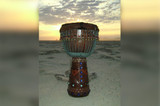Posture for Drummers
 As everyone knows, a drummer is a mysterious and unique sort of musician that provides the backbone for all types of music. Drummers can be called the foundation of all music, from rock and jazz to Latin, country and even in drum circles. These musicians are responsible for keeping the beat alive, steady and interesting, but with responsibility comes several factors that any drummer should take into consideration, including ways to reduce injury while on stage or jamming with friends.
As everyone knows, a drummer is a mysterious and unique sort of musician that provides the backbone for all types of music. Drummers can be called the foundation of all music, from rock and jazz to Latin, country and even in drum circles. These musicians are responsible for keeping the beat alive, steady and interesting, but with responsibility comes several factors that any drummer should take into consideration, including ways to reduce injury while on stage or jamming with friends.
Drumming is a high-energy activity that has a definite “workout effect,” no matter what type of drum or music is played. With an emphasis on full-body motion, a drummer can be at risk for injury just by playing an extended session of drumming, especially if she or he does not warm up before drumming or take breaks while drumming. Most importantly, the posture a drummer takes can have an overall effect on the drumming experience, both for the drummer and the audience, as the correct posture allows a drummer a better range of motion and the ability to play for longer periods of time without fatigue.
Drumming posture does depend on the type of drum played. For instance, a cajon drum player must sit on top of the drum while playing the sides and front of the instrument. A hunched back is one of the biggest complaints of cajon drummers, creating the perfect recipe for fatigue and injury to the back. To remedy this unnatural drumming posture, be sure to sit toward the back of the cajon and play the drum toward the top, eliminating the urge to reach down compromise the health of the spine.
Drum set drummers have challenges when it comes to posture, as well, and no two drummers drum the same or have the same equipment. A good rule of thumb when it comes to eliminating the possibility of injuries to the drummer is to be sure to sit in a natural, comfortable position, with the legs at 45 degree angles, and thighs parallel to the floor. Relax the arms and keep the back straight. Also, any drummer should keep in mind the quality and comfort of the drum throne chosen, as the seat, build and height can all add to the overall ease of drumming while practicing or during a performance.
For hand drums like the djembe or bongos, the posture can vary, depending on several factors. Some hand drums come with straps for those who prefer playing while standing or walking, while others may have stands that can be adjusted to the proper height for the drummer. For drummers who sit while playing a djembe or other hand drum, the proper posture depends mostly on the awareness of the body, and where the drum is placed. For these instruments, a general rule is to sit up straight while stabilizing the drum between the mid-thigh area.
Posture is one of the most important parts of keeping a drummer healthy. Even when not drumming, a drummer can practice the basics of drumming posture, such as sitting up straight and being aware of the spine. These practices can eliminate back strain and keep the rhythm hitting hard and strong throughout the music.
Recent Posts
-
What is the Best Size Djembe for Beginners?
If you're new to the world of percussion and interested in learning the djembe, you're in for a t …16th Jul 2024 -
The Benefits of Becoming a Drumming Teacher: Transforming Passion into Profession
Why become a drumming teacher? Becoming a drumming teacher is an excellent way to share your pas …22nd May 2024 -
What Makes the Djembe Drum a Spiritual Instrument in African Music?
Origin and history of the Djembe drum The Djembe drum originates from West Africa and holds sign …16th May 2024



